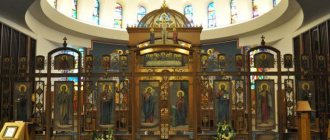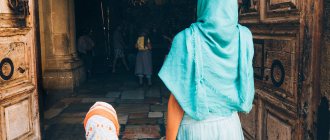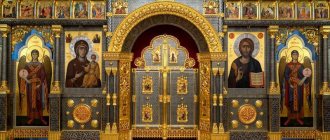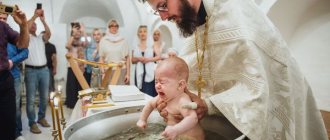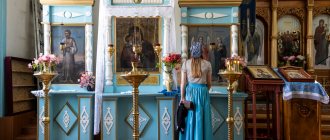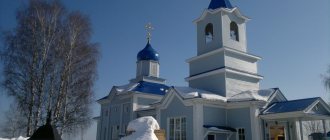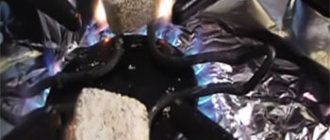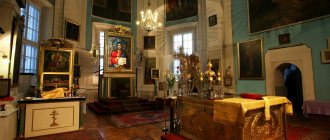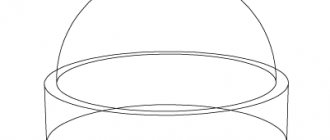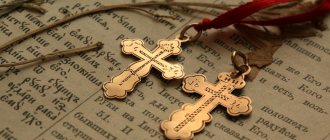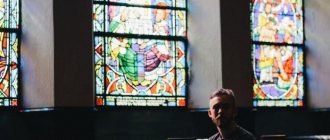"Save me, God!".
Thank you for visiting our website, before you start studying the information, please subscribe to our Orthodox community on Instagram, Lord, Save and Preserve † - https://www.instagram.com/spasi.gospodi/. The community has more than 60,000 subscribers. There are many of us like-minded people and we are growing quickly, we post prayers, sayings of saints, prayer requests, and timely post useful information about holidays and Orthodox events... Subscribe. Guardian Angel to you!
Orthodox believers often visit a church or temple to worship before the saints. But few people know how it is tripled. It consists of several parts: the altar with soleya, the vestibule, and the temple.
Each part carries a special meaning and has its own purpose. One of the most mysterious places is the altar in the Orthodox Church. It is in it that the sacrament of the Eucharist takes place. Since this part of the temple is mostly closed from the eyes of parishioners, many believers are interested in what is in it. Let's try to understand this in more detail.
What is an altar?
The altar in an Orthodox church is the main, most sacred room. It is located in the eastern part of the building and is separated from the main part of the temple by the iconostasis and solea. In architectural terms, the altar, as a rule, is an apse - a semicircular extension to the main building.
The word "altar" comes from two Latin words: alta
and
ara
, meaning "exalted altar" or "altar placed on a high place." The floor in the altar is always higher than the floor level of the main part of the church room, which indicates its special holiness.
In the Catholic West, the altar refers to the throne of the temple, and the room itself is called the presbytery. Sometimes in the West, an altar is a sacred image located behind the throne - for example, the Golden Altar of Pala D'o ro
in St. Mark's Basilica in Venice. The same word was used to call ancient altars: Old Testament and pagan.
What is a cross-domed church
Isaac Levitan. Evening bells (fragment). 1892. State Tretyakov Gallery, Moscow
Vladimir Ovchinnikov. Spring is coming (fragment). 1972. Private collection
Mikhail Nesterov. Vision to the youth Bartholomew. 1889–1890. State Tretyakov Gallery, Moscow
The Byzantine Emperor Constantine the Great issued an edict of religious tolerance in 313, and Christianity in the Eastern Roman Empire received equal rights with pagan religions. After this, Christian churches began to be built in Byzantium. The first buildings resembled a Roman basilica - a rectangular building for court hearings, political meetings and trade transactions. It consisted of one, three or five naves - longitudinal halls that were separated by pillars or columns. The central nave was higher and wider than the side ones, and also ended with an apse - a special semicircular extension where the seat of the judge or head of the assembly was located.
In the 5th–8th centuries, the architecture of the Christian church changed. He had a transept - another longitudinal hall that crossed the central nave at a right angle. So the plan of the temple began to resemble a cross, and at the place where its two “crossbars” intersected, a square space called the middle cross arose. The roof above it began to be crowned with a dome. This form was not chosen by chance. The cube in the Bible symbolized the earth, and the dome symbolized the endless movement of the Lord. Together they reminded of the connection between Heaven and earth. By the 9th century, the cross-domed system had become the main form of church in Orthodox countries.
Who can be in the altar?
Only clergy and clergy are allowed to enter the altar. Male laymen can enter the altar only with special permission. Women are prohibited from entering the altar, with the exception of nuns who have a blessing. Of the female monastics, the altar, as a rule, includes abbess and sisters who are obedient to the altar girls - they help the priests during the service and clean the holy of holies. During the Sacrament of Baptism, male infants are brought into the altar - as a sign that one day they will be able to become priests if they wish.
What's in it
If we consider the structure of the altar from the inside, then this is what is in the altar of the Orthodox Church:
- throne,
- seven-branched candlestick,
- altar,
- vasculature,
- sacristy.
The throne is in the center of the altar. Liturgies are held there. It is a symbol of the Holy Sepulcher. Thousands of pilgrims flock to Jerusalem to visit the Church of the Holy Sepulcher in Israel to strengthen their faith and give strength.
The modern seven-branched candlestick today serves as a lamp. There are seven lamps on it, which are lit during the service. It symbolizes the High Place.
To the right of it is an altar. On it a proskomedia is performed in the church. And to the right of the throne there is a vessel guard and a sacristy. Sacred vessels are kept here during times when there is no service.
The best article for you, go to: Patron saints of family and marriage
The Lord is always with you!
Layout options
A temple may have one or more altars. They can be located either next to each other or in parts of the building distant from each other: for example, sometimes altars are placed high in the choir. Altars located nearby can form a common room of complex shape.
Each altar has its own throne and altar. Also in the altar is the High Place with the bishop's throne. As a rule, adjacent to the altar is a sacristy - a place for storing sacred vestments and utensils.
From the history
In the Old Testament temple, the altar corresponded to the Holy of Holies - the most sacred part of the building. Only the bishop could enter there and only once a year.
Already the first Christians began to separate the space around the altar in places of worship, where, in fact, the Sacrament of the Eucharist was celebrated. At first, a small parapet served for this purpose; over time, an iconostasis was formed, which became increasingly higher.
Temple and its structure
Typically a temple[1] consists of a vestibule , a middle part and an altar .
The narthex is the western part of the temple. To enter it, you need to climb the steps to an elevated platform - the porch . In ancient times, the catechumens stood in the vestibule (this is the name given to those preparing to receive baptism). In later times, the vestibule became the place where, according to the rules, the betrothal, the lithium during the all-night vigil, the rite of announcement, and the prayer of women in labor are read on the fortieth day. The narthex is also called the meal, since in ancient times love suppers were held in this part, and later meals after the liturgy.
From the vestibule, a passage leads to the middle part , where worshipers are located during services.
Iconostasis
The altar is usually separated from the middle part of the temple by an iconostasis . The iconostasis consists of many icons. To the right of the royal doors is the icon of the Savior , to the left is the Mother of God . To the right of the image of the Savior there is usually a temple icon , that is, an icon of the holiday or saint to whom the temple is dedicated. On the side doors of the iconostasis are depicted the Archangels, or the first deacons Stephen and Philip, or the high priest Aaron and Moses. of the Last Supper is placed above the royal doors . The complete iconostasis has five rows. The first is called local: in addition to the icons of the Savior and the Mother of God, it usually contains a temple icon and locally revered images. Above the local one there is a festive row of icons: icons of the main church holidays are placed here. The next row is called deisis, which means “prayer.” In its center is the icon of the Savior Almighty, to the right of it is the image of the Mother of God, to the left is the Prophet, Forerunner and Baptist John. They are depicted facing the Savior, standing before Him in prayer (hence the name of the series). The images of the Mother of God and the Forerunner are followed by icons of the holy apostles (therefore, another name for this series is apostolic). Saints and Archangels are sometimes depicted in the deisis. In the fourth row there are icons of the holy prophets , in the fifth - the holy forefathers , that is, the ancestors of the Savior according to the flesh. The iconostasis is crowned with a cross.
The iconostasis is an image of the fullness of the Kingdom of Heaven; the Mother of God, the Heavenly Powers and all the saints stand at the Throne of God.
The altar is a special, holy, important place. The altar is the holy of holies of an Orthodox church. There is a throne on which the Sacrament of Holy Communion is performed.
At the altar
The altar is an image of the Kingdom of Heaven, a mountainous, sublime place. There are usually three doors leading to the altar. The central ones are called the royal doors . They are opened in special, most important and solemn places of service: for example, when the priest brings out the chalice with the Holy Gifts through the royal doors, in which the King of Glory, the Lord Himself, is present. There are side doors on the left and right of the altar barrier. deacons , most often pass through them during services .
Altar is translated as an elevated altar. And indeed the altar is located higher than the middle part of the temple. The main part of the altar is the Throne , on which the Bloodless Sacrifice is performed during the Divine Liturgy. This sacred action is also called the Eucharist, or the Sacrament of Communion. We'll talk about it later.
Throne
Inside the throne are the relics of saints, for in ancient times, in the first centuries, Christians celebrated the Eucharist at the tombs of holy martyrs[2]. On the throne there is an antimension - a silk cloth on which the position of the Savior in the tomb is depicted. Antimins translated from Greek means instead of a throne, since it also contains a piece of holy relics and the Eucharist is celebrated on it. At the antimension, in some exceptional cases (for example, during a military campaign), the Sacrament of Communion can be performed when there is no throne. On the throne stands a tabernacle , usually made in the form of a temple. It contains spare Holy Gifts for giving communion to the sick at home and in the hospital. Also on the throne is the monstrance , in which the priests carry the Holy Gifts when they go to give communion to the sick. On the throne is the Gospel (it is read during the service) and the cross . Immediately behind the throne there is a seven-branched candlestick - a large candlestick with seven lamps. The seven-branched candlestick was still in the Old Testament temple.
Behind the throne on the eastern side is a high place , which symbolically marks the heavenly throne or the chair of the eternal High Priest - Jesus Christ. Therefore, an icon of the Savior is placed on the wall above the high place. On the high place there is usually an altarpiece of the Mother of God and a large cross . They are used to wear during religious processions.
In those churches where the bishop serves, behind the throne on stands there are dikiri and trikiri - candlesticks with two and three candles, with which the bishop blesses the people.
Altar
In the northern part of the altar (if you look directly at the iconostasis), to the left of the throne, there is an altar . It resembles a throne, but smaller. The Gifts are prepared on the altar - bread and wine for the Divine Liturgy. On it are sacred vessels and objects: a Chalice (or chalice), a paten (a round metal dish on a stand), an asterisk (two metal arcs connected to each other crosswise), a spear (a spear-shaped knife), a spoon (a spoon for communion), covers for covering the Holy Gifts (there are three of them; one of them, large and rectangular in shape, is called air ). Also on the altar there is a ladle for pouring wine and warm water (heat) into the cup and metal plates for particles taken from the prosphora.
The purpose of sacred vessels will be discussed in detail later.
Another altar item is a censer . This is a metal cup on chains with a lid topped with a cross. Coal and incense or incense (fragrant resin) are placed in the censer. The censer is used to burn incense during the service. The incense smoke symbolizes the grace of the Holy Spirit. Also, the incense smoke rising upward reminds us that our prayers should ascend upward to God, like the smoke of a censer.
Symbolism
The altar symbolizes the Kingdom of Heaven, the place of God. It also reminds us of the Zion Upper Room, where the Lord Jesus Christ celebrated the Last Supper. We partake of this Supper at every Divine Liturgy, since time does not exist in the Heavenly World. Orthodox Christians believe that the altar is the place of special Divine grace. In the altar of the temple there is always an angel given to it during consecration. If the temple is destroyed, the angel will remain in his place until the Second Coming and the end of the visible world.
Purpose and symbolism
The main purpose of the altar is to depict the room in which the Last Supper took place. Thus, believers take a direct part in the celebration of the Easter meal, where the refraction and offering of holy gifts took place. Like the New Testament decorated upper room, they try to keep the altar clean and decorate it in every possible way.
Altar symbolism
Depending on the form of worship, the symbolism of the altar may change. It is often called the sanctuary. The origin of this designation is found in the Old Testament, and goes back to the ancient tabernacle, the invisible abode of the Lord. Just as Moses and Solomon kept the Holy of Holies in the temple, so in the altar, in the tabernacle, are the Body and Blood of Christ. However, the sanctification of the altar is intended to highlight the significance of the place, and not to liken the device with another religious building.
The sanctity of the altar is so revered that until the beginning of the last century, lay people were forbidden to enter there. The only exception was deaconesses in nunneries and only for cleaning, lighting lamps and censers. The roots of this tradition go deep into the past of Christianity, even before the separation of Catholicism.
Later, readers, subdeacons and altar servers began to be allowed into the altar only with the blessing of the bishop. Also, it was not customary to keep any icons in the altar, except those of the Mother of God, or those depicting non-holy people. This kind of reverent attitude continues to this day. Despite some concessions in the form of allowing men into the altar, the altar occupies a central place in Christian worship.
What was the first stone temple in Rus'
Apollinary Vasnetsov. Trinity Church on Bersenevka (fragment). 1922. Memorial museum-apartment of A.M. Vasnetsova, Moscow
Vasily Polenov. Moscow courtyard (fragment). 1878. State Tretyakov Gallery, Moscow
Boris Kustodiev. Fair (fragment). 1906. State Tretyakov Gallery, Moscow
Byzantine architecture also influenced the architecture of Kievan Rus. After Prince Vladimir declared Orthodoxy the state religion in 988, Christian churches also began to be built here. In 989, next to his tower in Kyiv, Vladimir founded the cathedral - the first stone cross-domed church in Rus'.
Greek architects took six years to build it. On May 12, 996, the temple was consecrated in honor of the Most Holy Theotokos. Prince Vladimir allocated a tenth of his income - tithe - for the maintenance of the church and the metropolis, which is why it was called Tithe.
The temple has not survived, but archaeologists and historians who studied the chronicles have restored its appearance. The main building was divided by pillars into three longitudinal naves. On three sides, except the eastern one, the church was surrounded by a gallery. It contained a baptismal chamber and a staircase tower along which they climbed to the second tier - the choir. According to Byzantine tradition, singers were stationed there. Vladimir made the upper tier a princely box. There he was with his retinue during worship, discussed political affairs and received foreign guests. Inside, the temple was decorated with frescoes, mosaics, columns with carved capitals and marble panels.
How frescoes show the sacred structure of the world
Vasily Polenov. Assumption Cathedral. Southern Gate (fragment). 1877. State Tretyakov Gallery, Moscow
Alexander Makovsky. Painting of the Church of the Savior in Nereditsa in Novgorod (fragment). 1913. Church and archaeological office of the Moscow Theological Academy, Sergiev Posad, Moscow region
Fedor Klages. Interior view of the Cathedral of Christ the Savior (fragment). 1883. State Russian Museum, St. Petersburg
Inside, the walls and vaults of the ancient Russian temple were painted with frescoes. Its internal space reflected the sacred structure of the world. The upper part of the temple symbolized the spiritual sky. Therefore, in the central dome they placed the image of Christ Pantocrator - the Lord of the world, who holds a book in his left hand and blesses with his right. And on the sails - the elements on which the dome is supported - four evangelists were depicted.
The lower part of the temple, on the contrary, personified the earthly world. Therefore, scenes from the earthly life of Christ were placed clockwise on the southeastern wall, and martyrs, saints and saints were depicted on the pillars.
A believer could read an Orthodox church like the Bible. The frescoes on the southern and northern walls showed the events of the sacred history of the Old and New Testaments. On the western wall, above the entrance, there were paintings of the Last Judgment and stories about the creation of the world. And the images in the apse were dedicated to Communion, in which the apostles and the Mother of God participate. The rest of the space was filled with patterns - floral and geometric.
